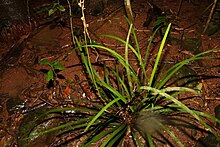Romnalda
| Romnalda | |
|---|---|

| |
| Romnalda strobilacea | |
| Scientific classification | |
| Kingdom: | Plantae |
| Clade: | Tracheophytes |
| Clade: | Angiosperms |
| Clade: | Monocots |
| Order: | Asparagales |
| Family: | Asparagaceae |
| Subfamily: | Lomandroideae |
| Genus: | Romnalda P.F.Stevens[1] |
Romnalda is a genus of monocotyledonous plants in the family Asparagaceae, subfamily Lomandroideae.[2] (They have also been placed in the Xanthorrhoeaceae.) As of December 2013 four formally named species are known and accepted by botanical science.[1][3][4]
The name Romnalda is an anagram of Lomandra, a related though more common genus of hard–leaved lily-like plants. The genus Romnalda differs from Lomandra in growing exclusively in rainforests and having sparsely branched inflorescences with no spines.
Plants have strap-like leaves and grow up to one metre (3 feet) tall often with a trunk and stilt roots reminiscent of a miniature Pandanus. Species of Romnalda grow naturally in Queensland and Papua New Guinea.
Species
- R. grallata – restricted to cloud forests on a few misty peaks in the Daintree Rainforest, Wet Tropics region, north-eastern Queensland.[5][6]
- R. ophiopogonoides,[3] synonym: Romnalda sp. Cooper Creek (P.I.Forster+ PIF4402) Qld Herbarium – only found in a few isolated locations around Cooper Creek, Wet Tropics region, north-eastern Queensland; and has obtained the Queensland government's official conservation status listing of "vulnerable" species.[7]
- R. papuana – only found in a handful of locations in Papua New Guinea including the island of New Britain.[8]
- R. strobilacea – restricted to basaltic soils north of Brisbane in South East Queensland, Australia;[9] and has obtained the Australian national and Queensland governments' official conservation status listings of "vulnerable" species.[7][10]
References
- ^ a b "Romnalda%". Australian Plant Name Index (APNI), Integrated Botanical Information System (IBIS) database (listing by % wildcard matching of all taxa relevant to Australia). Centre for Plant Biodiversity Research, Australian Government. Retrieved 8 Dec 2013.
- ^ Stevens, Peter F. (Sep 2013) [2001 onwards]. "Angiosperm Phylogeny Website – Asparagales: Lomandroideae". Version 13, 28 Sep 2013 with ongoing updates. Retrieved 1 Dec 2013.
- ^ a b Conran, John G.; Forster, Paul I.; Donnon, Mathew (2008). "Romnalda ophiopogonoides (Asparagales: Laxmanniaceae), a new and endangered species from the Wet Tropics bioregion of north-east Queensland" (PDF). Telopea. 12 (2). pp. 167-178, figs. 3-5. doi:10.7751/telopea20085808. Retrieved 8 Dec 2013.
- ^ "Romnalda". World Checklist of Selected Plant Families. Royal Botanic Gardens, Kew. Retrieved 4 Dec 2013.
- ^ Cooper, Wendy; Cooper, William T. (June 2004). "Romnalda P.F.Stevens". Fruits of the Australian Tropical Rainforest. Clifton Hill, Victoria, Australia: Nokomis Editions. p. 561. ISBN 9780958174213. Retrieved 1 Dec 2013.
- ^ F.A.Zich; B.P.M.Hyland; T.Whiffen; R.A.Kerrigan (2020). "Romnalda grallata". Australian Tropical Rainforest Plants Edition 8 (RFK8). Centre for Australian National Biodiversity Research (CANBR), Australian Government. Retrieved 21 June 2021.
- ^ a b Queensland Government (27 Sep 2013). "Nature Conservation (Wildlife) Regulation 2006" (PDF). Nature Conservation Act 1992. Online, accessed from www.legislation.qld.gov.au. Australia. p. 55. Retrieved 1 Dec 2013.
- ^ Papua New Guinea National Herbarium, Lae, Morobe Province, Poster Ecology and Conservation of Romnalda papuana.
- ^ S.G.A.P. (Qld Region) Logan River Branch Inc (2005). Mangroves to Mountains: A field guide to the native plants of south-east Queensland. Vol. 2. Browns Plains, Qld: Logan River Branch SGAP (Qld Region) Inc.
- ^ Romnalda strobilacea, Species Profile and Threats Database, Department of the Environment and Heritage, Australia. Retrieved 5 Dec 2013
- Henderson, R. J. F. (1986).In: George, A. S. (ed.) Flora of Australia, Vol. 46. Canberra: Australian Government Publishment Service, pp. 91–92
